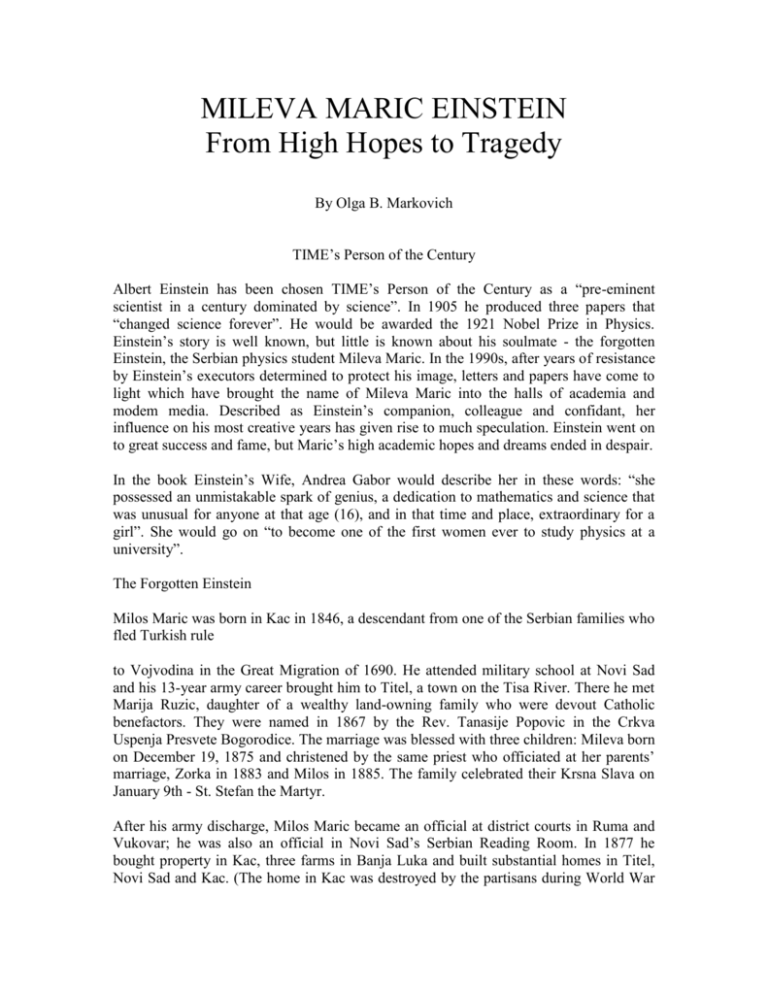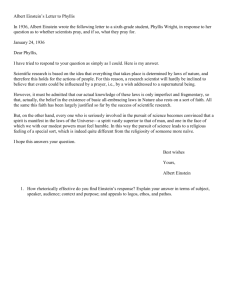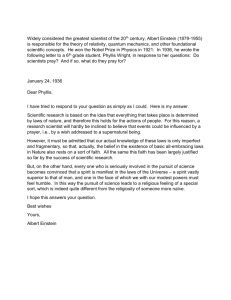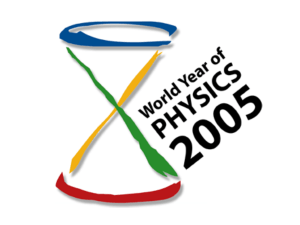Mileva Maric Einstein - Tesla Society Switzerland
advertisement

MILEVA MARIC EINSTEIN From High Hopes to Tragedy By Olga B. Markovich TIME’s Person of the Century Albert Einstein has been chosen TIME’s Person of the Century as a “pre-eminent scientist in a century dominated by science”. In 1905 he produced three papers that “changed science forever”. He would be awarded the 1921 Nobel Prize in Physics. Einstein’s story is well known, but little is known about his soulmate - the forgotten Einstein, the Serbian physics student Mileva Maric. In the 1990s, after years of resistance by Einstein’s executors determined to protect his image, letters and papers have come to light which have brought the name of Mileva Maric into the halls of academia and modem media. Described as Einstein’s companion, colleague and confidant, her influence on his most creative years has given rise to much speculation. Einstein went on to great success and fame, but Maric’s high academic hopes and dreams ended in despair. In the book Einstein’s Wife, Andrea Gabor would describe her in these words: “she possessed an unmistakable spark of genius, a dedication to mathematics and science that was unusual for anyone at that age (16), and in that time and place, extraordinary for a girl”. She would go on “to become one of the first women ever to study physics at a university”. The Forgotten Einstein Milos Maric was born in Kac in 1846, a descendant from one of the Serbian families who fled Turkish rule to Vojvodina in the Great Migration of 1690. He attended military school at Novi Sad and his 13-year army career brought him to Titel, a town on the Tisa River. There he met Marija Ruzic, daughter of a wealthy land-owning family who were devout Catholic benefactors. They were named in 1867 by the Rev. Tanasije Popovic in the Crkva Uspenja Presvete Bogorodice. The marriage was blessed with three children: Mileva born on December 19, 1875 and christened by the same priest who officiated at her parents’ marriage, Zorka in 1883 and Milos in 1885. The family celebrated their Krsna Slava on January 9th - St. Stefan the Martyr. After his army discharge, Milos Maric became an official at district courts in Ruma and Vukovar; he was also an official in Novi Sad’s Serbian Reading Room. In 1877 he bought property in Kac, three farms in Banja Luka and built substantial homes in Titel, Novi Sad and Kac. (The home in Kac was destroyed by the partisans during World War II as they ravaged the homes of wealthy landowners who were unable or refused to give provisions to the army.) Mileva (called Mitza by her family), who was born with a congenital hip displacement, was Milos’ favourite child and he taught her many things so that by the age of seven she was reading, doing simple arithmetic and was fluent in Serbian and German. She also read music and played her father’s favourite songs on the tamburitza. Brilliant Student & Trailblazer Seeing the potential in his daughter, Milos pushed her to strive for excellence. She attended elementary school in Ruma and in 1866 she began the first form of the Serbian girls’ high school in Novi Sad. From 1888 to 1890 she attended school in Sremska Mitrovica when, according to Highfield and Carter in their book The Private Lives of Albert Einstein, “her father sent her across the border into Serbia. Milos wanted his daughter educated at a gymnasium, but those in Austro-Hungary were for boys only. The same barriers no longer existed in Serbia, and Mileva entered the fifth form of the gymnasium at Sabac”. She excelled in mathematics and physics, German and French, and produced detailed sketches of local village scenes. Here she met Ruzica Drazic with whom she would later share student lodgings in Zurich. In May 1892 Milos was appointed to the High Court in Zagreb (Agram) and Mileva, by special dispensation, was enrolled as a private pupil at the city’s all-male Royal Classical High School which, write Highfield and Carter, “made her one of the first young women in the Austro-Hungarian Empire to sit alongside boys in a high-school classroom”. She was admitted to the girls’ high school in Zurich on November 14, 1894. She passed her matriculation exam in the spring of 1896 and began medical studies at Zurich University. She studied medicine for one summer term and in October switched to Section VIA of the Swiss Federal Polytechnical School (ETII) reading for a diploma that would qualify her to teach mathematics and physics at secondary schools. At close to 2l, she was the only woman to join Section VIA that year and was only the fifth woman to be accepted at the school. She also audited courses for one semester at the University of Heidelburg. Returning to Zurich, she studied math and physics and worked on her dissertation on the topic of thermoconduction in the hope of completing her doctorate. In her first year her highest mark was in physics: 5.5. In Zurich she lodged with her Sabac schoolmate Ruzica Drazic, Milana Bota from Krusevac and met her best friend Helene Kaufler (later Savic) from Vienna. In her class of six students, in which she was the only girl, she met Albert Einstein who was three and a half years younger. Then, as Gabor writes, “after years of academic triumph, Maric lost her momentum. Mysteriously, in the summer of 1901, Maric failed the second round of examinations, and about the same time, she also gave up the work on her dissertation”. What happened? Einstein. It is interesting to speculate what Maric would have accomplished if she had not fallen in love with him. Mrs. Einstein Academic failure, the trials of courtship with Einstein, the shame of an illegitimate pregnancy and the loss of her first child all had a dramatic effect on the future course of Mileva’s life. But through all her misfortunes she never lost the support of her family. The recent discovery of the 54 love letters of Einstein/Maric, beginning in 1897 and ending shortly after their marriage, shows that Einstein regarded Maric as ?a creature who is my equal and who is as strong and independent as I am?. Because of his mother?s objections, Einstein delayed their wedding until after the first child - Lieserl - was born! (What happened to the child is the subject of a recent book - Einstein’s Daughter - The Search for Lieserl by Michele Zackheim.) They were married in the Berne City Hall in January 1903 when Maric was 25 and Einstein 21. Throughout their courtship and marriage Maric was Einstein’s sounding board. “Maric’s faith and support were like a rock beneath him, at a time when he had little else to be sure of”, wrote Highfield and Carter. She provided Einstein with emotional resources and helped him in his work by solving certain problems, checking for slip-ups and proofreading his papers. In essence, she subordinated her professional goals to his. On March 27, 1901 Einstein wrote to her: “You are and will remain a shrine for me to which no one has access; I also know that of all people, you love me the most, and understand me the best... I’ll be so happy and proud when we are together and can bring our work on relative motion to a successful conclusion!” Gabor writes: “During the early years of their marriage, which are also the most productive period of Einstein’s career, Einstein credits Maric with “solving all of his mathematical problems”, a fact confirmed by their son Hans Albert, as well as by at least one student who lived for a time with the Einsteins?. “Much of the debate revolves around fragmentary evidence suggesting that the original version of Einstein’s three most famous articles, on the photoelectric effect, on Brownian motion, and on the theory of relativity were signed Einstein-Marity, the latter being a Hungarianized version of Maric. Although the original manuscripts have been lost, Abraham F Joffe, a member of the Soviet Academy of Sciences, claimed that he saw the original papers when he was an assistant to Wilhelm Rontgen who belonged to the editorial board of Annalen der Physik which published the articles. (An article in a 1955 Soviet journal quotes Joffe, now deceased, as ascribing the 1905 papers to “EinsteinMarity”)”. Gabor goes on, “Svetozar Varicak, a student who lived with the Einsteins for several months in about 1910, remembered how Maric, after a day of cleaning, cooking and caring for the children, would then busy herself with Einstein’s mathematical calculations, often working late into the night. Varicak said he remembered feeling “so sorry for Mileva” that he sometimes helped her with the housework”. Maric also told her family and friends about their work. Gabor writes: “She told Milana Bota about the work she was doing with Einstein. And in 1905, just after the completion of “On the Electrodynamics of Moving Bodies”, the initial paper on special relativity, while the Einsteins were on vacation in Serbia, Maric boasted to her father and Desana Tapavica Bala, who was married to the mayor of Novi Sad: “Just before we left for Novi Sad, we finished some important work that will make my husband famous”. Believing in his potential, Maric put Einstein’s interest ahead of her own. At one time, when the family was struggling, she inquired in a letter to Helene Savic about possible teaching positions for her husband and herself in Belgrade. But all her support was in vain, the marriage started to disintegrate in 1914 and they were divorced in 1919. Maric, still in love with Einstein, suffered a physical and emotional breakdown. And future Einstein biographers dismissed her contributions and almost expunged her name from history. Devoted Mother Maric’s marriage to Einstein produced two sons. Hans Albert (1904-1973), a hydraulic engineer who was an international authority on sediments and flood control and whose expertise helped shape the development of the Mississippi, the Missouri, and the Rio Grande Rivers and rivers in Thailand and India. He was a professor of hydraulic engineering at the University of California at Berkeley from 1947 to 1971. Married twice, he had three children. The second son, Eduard (1910-1965), was gifted in music and literature and studied psychiatry and medicine. He suffered a nervous breakdown in 1929 and was diagnosed as a schizophrenic. Maric devoted her life to his care. Frequently hospitalized, she lived frugally and her children became the focus of her life. As a part of the divorce settlement Maric received the proceeds of the Nobel Prize but expensive medical costs soon ate it all up. To make ends meet she gave private lessons in mathematics, physics and the piano. On September 22, 1913, Zastava, a Novi Sad newspaper published the following announcement: “Yesterday in the local Serbian Orthodox Church were baptized two little Swiss, sons of Albert Einstein, grandsons of our esteemed friend and fellow citizen, Milos Maric”. The kum was Dr. Laza Markovic. Physically, mentally and financially exhausted Maric died alone at the age of 73 on August 4, 1948. She was buried in Zurich?s Nordheim cemetery where, according to Highfield and Carter, “her grave has since vanished in the course of reorganization. Her death notice in the local papapers carried no mention of her former husband: “the passing to eternal rest of our beloved mother, Mileva Einstein-Marity” was recorded in the names of Hans Albert and Frieda Einstein of Berkeley, California, and Eduard Einstein”. At her death Eduard was institutionalized and died in a mental hospital in 1965. His death certificate identified him as Einstein’s son even though his father hadn?t seen him in thirty years. Maric who cared for him until her dying breath received no mention, at all. Even in death her destiny was tragic. Maric Rediscovered Mileva Maric may have been the forgotten Einstein during her lifetime, but due to the publication of the Einstein/Maric letters she is now getting recognition. Her contributions are hotly debated in the halls of academia and many articles and books are now devoted to her. A panel discussion at the annual meeting of the American Association for the Advancement of Science in New Orleans in 1990 dealt with the question of how much Maric had contributed to Einstein’s work. Many arguments broke out and since then there have been many newspaper articles about the two Einsteins. Maric’s champions are Evan Harris Walker, a research physicist in the United States Army Ballistic Research Laboratory at the Aberdeen Proving Grounds in Maryland and Dr. Senta Troemel-Ploetz, a research linguist at the German Research Society in Bonn. There was also a symposium devoted to Mileva Maric Einstein in October 1995 in Novi Sad. The first biography of Mileva Maric was the excellent U Senci Alberta Ajnstajna by Desanka Djuric Trbuhovic, published by Bagdala in Krusevac in 1969. The German edition, Im Schatten Albert Einsteins was published in Berne in 1983 and went into several printings. The book has now been translated into English by Karlo Baranj of Sweden with the copyright owned by Alan Adelson. Hopefully this English edition will be published soon. Plays and novels have also been devoted to her: Mileva Ajnstajn, a drama in two acts by Vida Ognjenovic and the novels Mileva Maric by Dragana Bukumirovic and Mrs. Einstein by Anna McGrail. Two books came out in 1999: Einstein in Love: A Scientific Romance by Dennis Overbye and the excellent Einstein’s Daughter - The Search for Lieserl by Michele Zackheim. It seems Mileva Maric’s life which was filled with obscurity, love and betrayal, promises and unbearable suffering will be brought to the forefront in the new millennium and she will take her rightful place in history. The Search for Lieserl Michele Zackheim’s book Einstein’s. Daughter: The Search for Lieserl is an excellent book which can be read on several levels: a mystery describing the search for the first child of Albert Einstein and Mileva Maric Einstein; as a biography of Mileva Maric; as the story of her family and how her relatives remember her; as a depiction of life in Vojvodina and Serbia both at the beginning and the end of the 20th century. Zackheim realized that in order to find the child, she would have to know Mileva and in order to know her she would have to understand the “cultural heart of Serbia”. The book is based on more than one hundred interviews and vast research through Serbian archives, history and literature so that Zackheim could tell the story “iz prve ruke”. It is also the story of descendants, of Mileva’s relatives today - second cousin Dragisa Maric, first cousin Ljubica Maric, second cousin Jovan Ruzic, first cousin Sofija Galic Golubovic - and descendants of Mileva’s best friends - Helene Savic’s grandson Dr. Milan Popovic and Milana Bota Stefanovic’s grandchild Ivana Stefanovic. Previously unknown letters and photographs were shown to Zackheim so she could tell Maric’s story. Maric’s biographer was a Serbian mathematician and physicist, Desanka DjuricTrbuhovic, whose U Senci Alberta Ajnstajna was first published in 1969 and has since been published in German and translated into English. This is the most complete and definitive biography written about Maric and is the primary source about her life consulted by writers and researchers. Zackheim consulted her son, Professor Ljubomir Trbuhovic, in the writing of her book. Einstein’s Daughter is a book of memories which brings the Maric era to new light. There is a description of her maternal great-grandfather Ruzic who “ordered two enormous brass bells from “Vienna for Titel’s newly built church. The bells traveled by train through Central Europe, connecting in Budapest, then passing through the bountiful plains that surrounded Novi Sad and on to Kac, Budisava, Sajkas, Vilovo, Lok, finally stopping at Titel. Since the church was three kilometres from the train depot, a team of six oxen, their horns adorned with apples, and a wagon were brought from Ruzic’s ranch. The bells were loaded onto the wagon in silence. Ruzic walked alongside as the small procession commenced its journey to the church. People from the village and countryside lined the dirt road and tossed brightly colored pieces of fabric at them. Ruzic and the oxen were covered in color. At the church, the priest gave a blagoslov, a blessing, and sprinkled the bells with holy water. The bells were then hoisted up into the tower with ropes and installed by local carpenters. In two hours, they rang out over the village. “During his lifetime Ruzic never acknowledged his gift. Bragging was considered as impolite as speaking about family disgraces”. There are also memories of Albert Einstein in Novi Sad while visiting the Maric’s on Kisacka Street. He likedto spend time at the Queen Elizabeth Cafe which formed part of the hotel owned by Lazar Dundjerski one of the wealthiest men in Vojvodina. Sitting on the back patio, Einstein would read and visit. “Even today Novi Sad residents tell stories about Albert’s loquacity and laughter. It was on this patio that Albert was remembered to have said he was “not against moderate alcohol consumption”. “Voila”, he exclaimed, “the Serb drinks from birth until death. When he is born, as he matures, when he travels, when he gets married, when he gets buried - and yet Serbs are a nation of geniuses. That is how I perceive them, based on my wife”. Zackheim also describes the church where the Einstein sonswere christened. “Nikolajevska, St. Nicholas, the oldest church in Novi Sad, was constructed in the baroque style around 1730. Inside, the walls are decorated with gold filigree that catches the light coming through the stained glass windows and from the hundreds of flickering candles. The patriarch of the church, Father Teodor Milic, was a famous singer, preacher, political radical, and a personal friend of Milos Maric’s (Mileva’s father)”. The author also touches on the Jews in Vojvodina. “Jews were a distinct minority in the villages of Vojvodina. ...Although an unspoken separation existed, anti-Semitism was not prevalent among the Serbs. Wherever there was a Catholic majority, especially in German and Hungarian neighborhoods, there were incidents of anti-Semitism, but the Orthodox Church was tolerant and not openly prejudiced against Jews?.” Zackheim must be commended for the vast amount of research she did in the archives of Vojvodina and Serbia. It is heartbreaking to read that "great chunks of the past have been destroyed in the chaos of war”. She tells the tale of how even today “the German government has in its museums and archives church icons and artifacts from Vojvodina which they refuse to return”. In addition, thirty train cars of records were stored in the salt mines of Czechoslovakia where “the Germans assembled a team of sixty scientists to review the material in an attempt to prove that the Kingdom of Serbia had been the aggressor that had instigated the First World War”. The records in Vojvodina and Serbia “lived under many regimes” and she was told how “at the end of the Second World War, the Communists recycled many of our old records into new paper’. During her research she con-suited thirty-two archives in Vojvodina, Serbia, Hungary and Austria. It is a blessing that she did her research when she did - traveling three times to Serbia twice while the country was at war for as she writes, “Today, in 1999, the most recent war has left the country in ruins. Many of the archives, government record offices, schools, hospitals and graveyards, where I did much of my research, have been damaged or destroyed”. Einstein’s Daughter is an excellent and enjoyable book. In fact, it is “unputdownable” - it will keep you reading through the night. Publisheed in Voice of Canadian Serbs , Thursday, January 27, 2000 - No: 2692 - Year 66 Bibliography Books Djuric-Trbuhovic, Desanka. U Senci Alberta Ajnstajna. Krusevac: Bagdala, 1969. Forbes, Malcolm. What Happened to Their Kids! Children of the Rich and Famous, Children of Albert Einstein. New York: Simon & Schuster, 1990. Gabor, Andrea. Einstein’s Wife: Work and Marriage in the Lives of Five Great Twentieth Century Women. New York: Viking Press, 1995. Highfield, Roger and Carter, Paul. The Private Lives of Albert Einstein. London: Faber & Faber, 1993. Renn, Jurgen and Schulman, Robert, eds. Albert Einstein/ Mileva Maric: The Love Letters. Princeton: Princeton UP, 1992. Zackheim, Michele. Einstein’s Daughter: The Search for Lieseri. New York: Riverhead (Penguin Putnam), 1999. Articles “Albert Einstein - Person of the Century”, TIME, December31, 1999. Chamberlain, Lesley, “A Daughter of Science”, Times Literary Supplement, February 13, 1998. “Did Einstein’s Wife Aid in Theories?”, New York Times; March 27, 1990. Garfield, Simon L. “First Wife’s Role in Einstein Work Debated”, Christian Science Monitor, February 27, 1990. Goodman, Ellen, “Relatives and Relativity: There Were Two Einsteins”, International Herald Tribune, March 16, 1990. Dennis Overbye, “Einstein in Love”, TIME, April30, 1990. Robinson, Paul A. Jr. “Early Einstein: The Young Physicist’s Papers”, Christian Science Monitor, October 11, 1987. Sullivan, Walter, “Einstein Letters Tell of Anguished Love Affair”, New York Times, May 3, 1987. Further Reading Bukumirovic, Dragana Mileva Maric Ajnstajn. Biblioteka Fatalne Srpkinje, Knjiga Broj 2. Beograd: Narodna Knjiga 1998. Einstein, Elizabeth Roboz. Hans Albert Einstein: Reminiscences of His Life and Our Life Together. Iowa Institute of Hydraulic Research, University of Iowa, 1991. (AppendixA contains Mileva Maric’s biography by Djordje Krstic.) McGrail, Anna. Mrs. Einstein, a novel. New York: Doubleday, 1998. Ognjenovic, Vida. Mileva Ajnstajn, Drama u Dva Dela. Beograd: Stubovi Kulture, 1998. Overbye, Dennis. Einstein in Love, A Scientific Romance. Boston: Little Brown, 1999.





